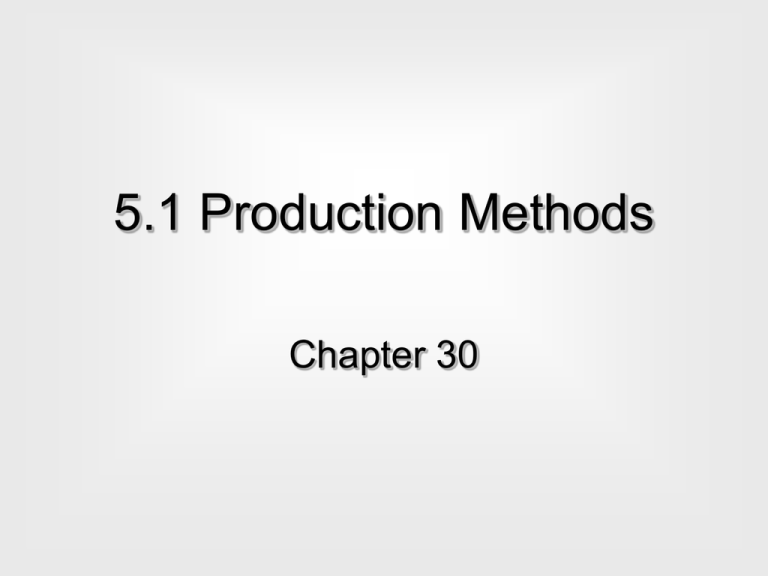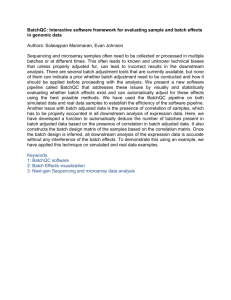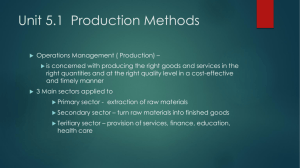IB2 Ch 30 Production Methods
advertisement

5.1 Production Methods Chapter 30 Production How goods and services are produced. Types of Production Job Production Batch Production Flow Production, Line Production, or Mass Production Mass Customization Cell Production (HL) Job Production Producing a one-off item specifically designed for the customer. – Can be small or large – but usually unique – Examples: Wedding cakes, draperies, Yangtze dam in China Pros: motivating for workers as they participate in the complete production process Cons: high unit costs per item Batch Production Products are made in separate groups with each group going through the complete process together – Examples: a baker making rolls, cheerleading uniforms Pros: enables economy of scale if batches are large enough, batches can be matched to demand, batch design can be changed Cons: high level of “work-in-progress” for each stage of production, the work may be boring and demotivating for workers, if batches are small unit costs may be high, cleaning may need to be completed between batches Flow Production or Line Production (Mass Production) Used when individual products move through one stage of production to next when the product is ready. – Examples: soda, pencils Pros: capable of producing large quantities in short time frames, and standardized items, labor costs are low because automated equipment is used, inputs can be easily determined because of constant known output, quality is consistent and easily checked at multiple stages of production Cons: high setup costs, boring repetitive tasks, demotivating for employees Video: http://science.discovery.com/videos/how-its-made-pencils.html Mass Customization Combines job production with mass production to customize products to suit individuals. – Examples: computers, automobile assembly Pros: designs include customized elements to standardized parts reducing consumer alienation, differentiated products for consumers, low unit cost for “customized” product, reducing boring and repetitive tasks Cons: high setup costs and equipment costs Summary Job Batch Flow/Line/Mass Mass Customization Main Feature Single one-off items Group of identical products pass through each stage together Mass production of standardized products Flow production with many standardized components but customized differences too Essential Requirements Highly skilled workforce Labor and machines must be flexible to switch to making batches of other designs Specialized, often expensive, capital equipment – but can be very efficient High steady demand for standardized product Many common components Flexible and multi-skilled workers Flexible equipment – often CAM to allow for variations in the product Main Advantages Able to undertake specialist projects or jobs, often with high value added High levels of worker motivation Some economies of scale Faster production with lower unit costs than job production Some flexibility in design of product in each batch Low unit costs due to constant working of machines, high labor productivity and economies of scale JIT stock management easier to apply than with other methods Combines low unit costs with flexibility to meet customers’ individual requirements Main Limitations High unit production costs Time consuming Wide range of tools and equipment needed High levels of stocks at each production stage Unit costs likely to be higher than with flow production Inflexible – often very difficult and time consuming to switch from one type of product to another Expensive to set up flowline machinery and each section needs to be carefully synchronized Expensive product redesign may be needed to allow key components to be switched to allow variety Expensive flexible capital equipment needed Cell Production Splitting flow production into self-contained groups that are responsible for whole work units. Performance Standards: Productivity measured, quality, lead times Pros: worker commitment and motivation is high because there is team work and sense of ownership in the work performed; job rotation within the cell, increased productivity Cons: need multi-skilled workers HL Cell Production Splitting flow production into self-contained groups that are responsible for whole work units. Performance Standards: Productivity measured, quality, lead times Pros: worker commitment and motivation is high because there is team work and sense of ownership in the work performed; job rotation within the cell, increased productivity Cons: need multi-skilled workers, need to be flexible, workers need to be responsible Bought-in components HL Machining of components and quality checks Sub assemblies produced and quality checks Finished goods Final assembly, quality checks packaging Switching from Job to BATCH Considerations when changing from job production methods to batch. – Finance Cost of equipment to handle larger volume of the batch Higher stocking levels require more finance – Human Resources Less emphasis in an individual’s craft could demotivate employees – Marketing Product is no longer custom May have to promote lower prices and consistency in quality Switching from Job or Batch to FLOW Considerations when changing from job or batch production methods to flow. – Finance Cost of equipment to handle a large volume of production Production delays during change over could create cash flow problems – Human Resources Low motivation and boredom could occur – Marketing Market research becomes important to target larger markets Accurate sales forecasting to match demand with output Promotion and pricing will have to change to be geared toward a mass market approach….this could change the direction of the business. Switching from Batch or Flow to CELL Considerations when changing from batch or flow production methods to cell. – Finance Cost of equipment to handle multiple products within a cell – Human Resources Recruitment or training of multi-skilled workers Creation of work teams – Marketing Productivity should create more competitive pricing Quality improvements should improve product Choose a Production Method Size of Market – Very small markets are suited for job or batch production – Flow production is useful for producing a large quantity of identical products for very large markets with consistent demand. – Batch production is suited for large production runs at intervals of time….3X per year Choose a Production Method Amount of Capital Available – Large amounts of capital are required for flow production systems – Small amounts of capital can be used to set up job or batch production methods Choose a Production Method Available Resources – Flow production requires large amounts of unskilled workers – Flow production requires land for large factories – Job and batch production requires a skilled work force More than One Way Most businesses use more than one way of producing their products. Land Rover – Line production of the standard products – Batch production of their military version – Job production for special orders that will be hand assembled (bullet proof glass, gold plated trim, Italian leather seats)





